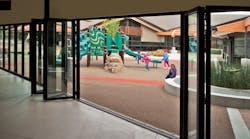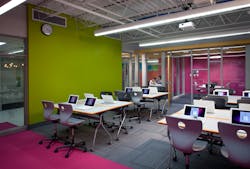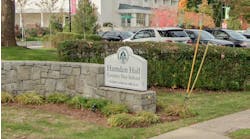Keeping up with today’s ever-advancing technology, shifting demographics and evolving educational objectives has become increasingly difficult for schools across the country. In many cases, entire districts and campuses are asking themselves, “How do we update our facilities and programs to best serve our students and plan for a future unknown, while best putting taxpayer dollars to use?”
School administrators and communities are turning to architects and planners for guidance as they embark on a “renaissance” of their campuses. Such projects often are enormous and complex; facility planners have a responsibility to help institutions do it right—creating a process that turns dreams into reality for students and teachers.
A successful process
Architects, planners and school administrators must keep in mind four keys elements when embarking on a district- or campuswide renaissance:
•Design a process and stick to it. Every student, teacher, administrator and campus is different. Likewise, each community is different—defined by a unique culture, political structure and demographics. It is not possible, therefore, for a district- or campuswide renaissance to be a “one size fits all” or recycled approach that is applied from community to community.
Listening carefully to community stakeholders as they articulate their vision and identifying their wants vs. needs is critical to designing an effective planning process. Parents, community members and administrators often want guarantees right away, which is nearly impossible. Instead, it is the responsibility of the architects and planners to design a straightforward process that inspires confidence that the long-term goals can be achieved.
The approach must be thorough and clearly demonstrate that every aspect of the plan has been considered. More than ever, taxpayers are taking an active role in educating themselves about where their money is being spent. Designing a comprehensive process builds confidence among community members that their voices are being heard.
•Do the due diligence, and be patient. It often can be challenging to tell a community that its schools will undergo an extensive—and expensive—overhaul. But giving community members the impression that decisions are pre-determined often can make it impossible to garner support.
It is the leaders’ responsibility to conduct the necessary due diligence, engage the community in the planning process, and clearly articulate the benefits. Taxpayers appreciate the opportunity to evaluate the pros and cons of any major community undertaking and are more likely to offer support if their concerns are addressed.
If a districtwide master plan is perceived as being rushed or undervalued, it can create significant challenges throughout every phase of the process. Although there may be a sense of immediacy from parents and school administrators who wish to see instant results, patience on the part of everyone throughout the project will create a more positive reception in the end.
•Engage the community on every level. Community engagement is perhaps the most important factor in the renaissance of a school district or campus. If the community is considered properly, the institution will be prepared sufficiently and have the necessary support. When the process begins, a “visionary”—someone who believes in the project passionately and can win community support—should be identified. Next, it is important to find other supporters of the project who are willing to share, listen and garner backing.
Community engagement can happen in many ways, but identifying key stakeholders first is crucial for long-term support. Town hall forums are an open invitation to learn and share, and surveys offer a quantitative analysis of support and resistance. No method of community engagement is a waste of time.
•Remain flexible and keep an open mind. Flexibility is key to the success of any renaissance. As the needs of students and their schools change rapidly, teachers have the monumental task of preparing children for jobs of the future. As a result, 21st-century education facilities designed to support students and teachers must be highly flexible and agile buildings that can grow and develop with the community they serve.
Additionally, master plan leaders themselves must remain flexible and be prepared to adapt to surprises. Keeping an open mind when challenges arise will help keep the process moving and maintain trust and support from everyone involved.
Paulsen is vice president, Pre-K to 12 Education Practice Leader, and Siepka is Pre-K to 12 Design Leader and senior designer for Wight & Company, Darien, Ill. The firm worked with the Des Plaines district (see sidebar).



